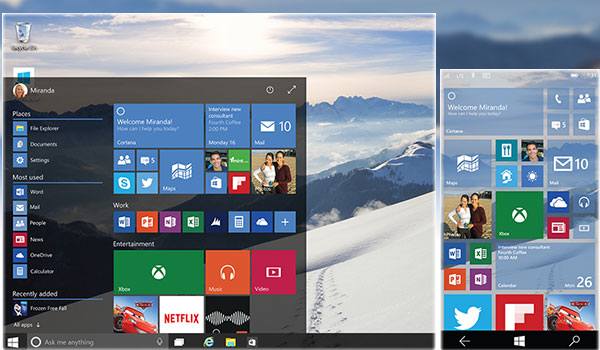Microsoft last week announced that Windows 10 was running on 300 million PCs and reminded customers that its free upgrade offer would end July 29. After that date, the price to upgrade to Windows 10 Home will be US$119.
“We’re pleased to see Windows 10 become one of the largest online services in less than a year,” said Yusuf Mehdi, corporate VP of Microsoft’s Windows and Devices Group.
Windows 10 services, including apps such as Photos, Groove Music, Movies & TV and Universal Windows Platform apps like Facebook and Instagram, are getting better and many more will be “coming in the upcoming Windows 10 Anniversary Update this summer,” he added.
To upgrade, consumers just need to accept Windows 10 when the pop-up window appears on their desktops.
On Track
Windows 10 “is moving much faster than any previous OS update,” said Steve Kleynhans, a research VP at Gartner. It’s “proceeding pretty much as we expected, and by July 29 they should be somewhere just shy of 400 million devices.”
Microsoft’s goal was to have 1 billion Windows 10 users within two to three years of Windows 10’s launch, and “I don’t think they will have any trouble hitting the target based on the level of acceptance we are seeing so far,” he told TechNewsWorld.
“The question isn’t whether Microsoft will hit 1 billion, but whether it happens in three years or closer to two,” Kleynhans said.
It’s in the company’s interest get users to upgrade.
“Microsoft obviously wants to reduce its operating costs, and supporting old operating systems is a high-cost obligation,” pointed out Mike Jude, program manager at Stratecast/Frost & Sullivan.
Down to Business
The upgrade likely has been mainly on consumer PCs, as it “comes with a number of strings that may not be suitable for businesses,” Kleynhans noted.
“Companies can’t just roll out a new OS; it takes months to build expertise, do appropriate testing and engineer a new environment,” he added. It may take a year or more to perform the updates once a business begins deployment.
“We’re seeing the early phase of enterprise adoption, with 83 percent of our enterprise customers in active trials today,” a Microsoft spokesperson said in comments provided to TechNewsWorld by company rep Lenette Larson. “There are positive early signals from customers with proof of concepts.”
However, “people aren’t exactly falling all over themselves to upgrade,” Frost’s Jude told TechNewsWorld.
“Upgrading to Windows 10 is a significant overhead many businesses don’t want to take on right now,” he said. “Couple that with the hypersensitivity of most businesses to possible security risks, and the risk associated with implementing an untried operating system may be unacceptable.”
The consumer space is having its own issues, Jude noted. “Most consumers keep their machines much longer than business does, and many of the existing machines simply can’t run Windows 10, mostly because of hardware limitations.”
Who Should Upgrade and How
The free Windows 10 upgrade is available to “qualified new or existing Windows 7, Windows 8.1 and Windows Phone 8.1 devices that upgrade by July 29,” the Microsoft spokesperson told TechNewsWorld.
Consumers cancheck whether their device is compatible with Windows 10.
Before upgrading, users should back up everything, Jude cautioned. “Make sure you have a load disc for your previous operating system and all of the applications that you use. If Windows 10 crashes on install, and even if it doesn’t, you want to be able to retreat to your last known good implementation.”
He uses Windows 7, which is stable, he said. He has tried to upgrade to Windows 10 on three machines but has “had issues on each that prevented a clean load. I think it needs some work.”
Businesses “ought to remain on Windows 7 at least until Windows 10’s security profile is better understood,” Jude suggested. “No one should stay with Windows 8 or 8.1.”
























































I think Microsoft will be content to let the free upgrades end for now. Although it remains to be seen how many will opt to pay $119 after Win 10 was offered for free this long? One could assume after a year, those who would upgrade would have done so. The question is, what will Microsoft do besides wait for Windows 7 support to expire to get the rest onboard? Just wait for people to buy new hardware? Maybe end support early for Win 7 and Win 8? I’m sure Microsoft does not want another XP hanging around. I’ve upgraded all my PC’s now to Windows 10. Not unimpressed but not totally sold on it’s user interface or it’s automatic updates. At times I think I upgraded too early and in some ways I don’t see it as an improvement to Windows 7. In fact my new Dell laptop requires a Intel beta graphic driver just so I do not get graphics that stop responding. After what 9 months we still have driver issue? For 3D this could be considered typical. But 2D graphics should not be crashing. My older HP desktop performs much better and is more stable. So one has to ask, is buying new hardware something to be done in another 6 months or longer? I know, that I wished I had waited. Microsoft will no doubt be pressured by PC makers to give up on the free upgrade. After all, they need that $119 upgrade charge to persuade people to buy new hardware, rather than upgrade old. But it remains to be seen if Windows 10 is liked enough to warrant that purchase. So far I AM not so sure anything about Windows 10 is sparking much interest.